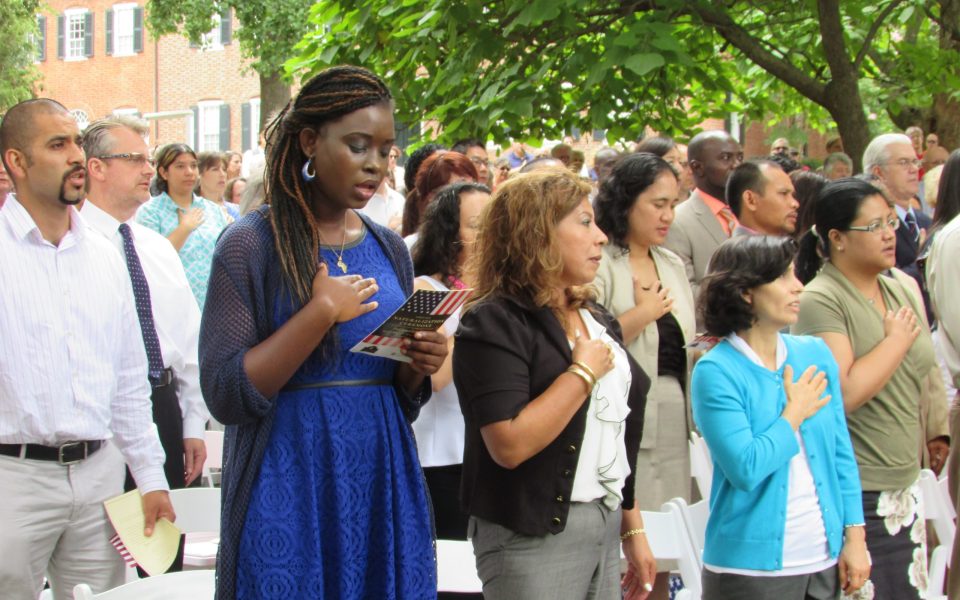by Jordan Green
Thirty-three people from 21 countries took the oath of citizenship on July 4 at Old Salem Museum & Gardens, where the first Fourth of July celebration in US history took place in 1783.
Agnes Beya came with her family from the Democratic Republic of the Congo on a family visa, and settled in Greensboro. Jeify Martinez came to High Point from the Dominican Republic to join her husband. Piers Clarkson, a native of the United Kingdom who lives in Winston-Salem, decided it was time to become a US citizen now that he has a 16-month-old son and his English parents live here.
They were three of the 33 immigrants from 21 countries who took the oath of allegiance to become citizens of the United States on July 4 at Old Salem Museum & Gardens in Winston-Salem, the site of the first Fourth of July celebration in 1783. It was the fifth year that the naturalization ceremony has been held at Old Salem on July 4.
Repeating after Leander Holston, a field office director for US Citizenship and Immigration Services, they declared that they would “absolutely and entirely renounce and abjure allegiance and fidelity to any foreign prince, potentate, state or sovereignty of whom or which” they had previously been a subject or citizen. They pledged to support and defend the Constitution “against all enemies, foreign and domestic” and to “bear arms on behalf of the United States when required by law.”
Stopping with her family to get a cup of punch and cookies served by the Daughters of the American Revolution, Beya easily explained the appeal of becoming a US citizen.
“The freedom, liberty and opportunity that it gives you when you come to this country,” she said. “We don’t have that where we are from. The name of the country says ‘democratic,’ but it’s not really.”
Beya’s brother blazed a trail for the family, arriving in 2003. He urged the family to join him. Beya’s father won a visa lottery, allowing the entire family to immigrate to Greensboro about five years ago. They like living here, Beya said. Although the Democratic Republic of the Congo has its challenges, that wasn’t the deciding factor in their decision to leave.
“It wasn’t really us running from something,” she said.
The process of becoming a citizen took place quickly, Beya said. She applied in February, and in March she appeared at the Citizenship and Immigration Services field office in Charlotte to have her fingerprints taken and her photo made — a process known as the biometric test. Six days before the naturalization ceremony, she returned to the federal office for her citizenship exam. After correctly answering about six questions, including the name of the first American president, Beya said the examiner went ahead and passed her.
The test was “not at all” difficult, she said. “They give you this book to study.”
DE Lorraine Sterritt, president of Salem Academy and College, could relate to the new citizens’ experience. She immigrated to the United States from Ireland in 1985, and took the oath of citizenship in Roanoke, Va. in 1990.
“You and I are here today because we learned American history from the bottom up and as outsiders looking in,” Sterritt said during the keynote speech. “If you are like me, you studied for a long time that book the INS gave you to prepare for the citizenship exam. I memorized the whole book, and when I showed up for the exam dressed in a business suit, I was prepared to recite the name of every US president in order because I had memorized them in order.”
Sterritt said she struggled when the examiner asked her to name two Indian tribes.
“Americans born in this country study this in the second grade; in Ireland, we do not,” she said. “But, as someone who had observed American civilization from the outside looking in, I drew on the knowledge that I had gained from watching many John Wayne westerns in my childhood in Ireland, I was able to say, ‘Apache and Sioux?’”
Sterritt quoted from Letters from an American Farmer, a 1782 manuscript by the writer J. Hector St. John de Crevecouer: “Americans are that great race of Western pilgrims who are carrying along with them the great mass of arts, sciences, vigor and industry which began long since in the east. They finish the great circle.”
The 33 new citizens seated before her continue that tradition, she suggested, albeit in ways the author might not have imagined.
“The 18th-Century American whom Crevecouer described, like the author himself, was a settler who had left Europe in order to establish his independence in North America,” Sterritt said. “Unlike Crevecouer’s ‘new man’ who began who began his life on the far side of the Atlantic Ocean, today’s new American men and women have come to this country not only from Europe, but also from Asia, [Central] and South America, Canada, Africa and the Middle East.”
Join the First Amendment Society, a membership that goes directly to funding TCB‘s newsroom.
We believe that reporting can save the world.
The TCB First Amendment Society recognizes the vital role of a free, unfettered press with a bundling of local experiences designed to build community, and unique engagements with our newsroom that will help you understand, and shape, local journalism’s critical role in uplifting the people in our cities.
All revenue goes directly into the newsroom as reporters’ salaries and freelance commissions.


Leave a Reply